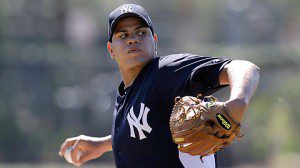
After an offseason of digesting colossal amounts of information about prospects, all the major writers and publications have slapped together the culmination of that work: the almighty prospect list. They’re subjective masterpieces of intellectual sweat and generate lots of discussion (not to mention page views) for people inside and outside the baseball industry. But, now with spring training in full effect, it’s time to start the process all over again and begin amassing a new season’s worth of information.
One of the most important things front-office decision makers, scouts and experts take into consideration as they shuttle pitching prospects up and down their pro boards is whether or not the pitcher can stick in a rotation. Even the most elite relievers are only as valuable as decent mid-rotation starters, and the probability that a player will give you 200+ innings instead of 60 or 70 plays a huge part in how a prospect is valued in trade discussions. No farm director in his right mind would move a pitcher to the bullpen unless he absolutely needed to. While it is an unwanted change, it happens often simply because young pitchers have a litany of hurdles to clear in order to pitch every fifth day in the big leagues. I have compiled here a list of those hurdles, why they matter and a few examples of prospects who may have to clear them. When you head to your local minor-league park this season to see a pitcher who has question marks, now you’ll know what to look for.
Stick me in the bullpen sign #1: shallow repertoire
To pitch through a major-league lineup multiple times in a single outing requires at least three viable major league pitches. Not only does it give the pitcher another weapon with which to get hitters out, it allows the pitcher to get creative with sequencing, thwarts aging guess-hitters, and embogs the in-game adjustments that good hitters make. If one of those pitches is a change-up or splitter, then you’re also offsetting platoon issues. Of course, there have been and will be exceptions every now and then. Randy Johnson only used two pitches, but both of those graded out as an 80 on the scouting scale. Cole Hamels worked almost exclusively off his fastball and change-up early on in his career, but he was sporting plus-plus command for a while. It caught up to him, an he has since adjusted.
Prospects with this issue: Matt Barnes (BOS), Trey McNutt (ChC), Nate Eovaldi (LAD), Tyler Thornburg (MIL), Matt Harvey (NYM), Chris Archer (TB), Alex Colome (TB)
Stick me in the bullpen sign #2: poor control
Walk-happy pitchers don’t pitch very deep into games. They burn out in the fifth inning or so and force the manager to dip into the bullpen, which is now faced with the task of accruing 12 outs. When you start Jonathan Sanchez, you’re really starting Jonathan Sanchez and an inning or two of a bad reliever. The wear on the pen and the use of bad relievers make using starters with poor control a sub-optimal decision.
Prospects with this issues: Casey Crosby (DET), Andy Oliver (DET), Jeurys Familia (NYM), Dellin Betances (NYY), Chris Archer (TB), Alex Meyer (WAS)
Stick me in the bullpen sign #3: health issues
There are really a few subsets of this category. First, a guy might end up in the bullpen due to injury issues caused by his lack of physicals size. Sometimes, smaller pitchers just can’t hold up under the 200+ inning workload. Whether that’s simply because of the size of their bodies, or because they need to pitch at full effort more often to blow hitters away since they often lack the natural downhill plane a taller pitcher would use to pitch to more contact, smaller pitchers give scouts pause.
Prospects that have height issues: Arodys Vizcaino (ATL), Dylan Bundy (BAL). Tyler Thornburg (MIL), Jenrry Meija (NYM), Sonny Gray (OAK), Carlos Martinez (StL), Brad Peacock (Oak)
The second potential cause of pitcher health issues is a violent delivery. Stiff, full-effort deliveries cannot only cause health problems, but are often the source of poor control as well.
Prospects with unsightly deliveries: Drew Pomeranz (COL), Jarred Cosart (HOU), Taylor Jungmann (MIL), Carlos Martinez (StL)
Of course, sometimes a pitcher’s injuries are the fault of external factors, such as Dusty Baker’s management, and other times we simply can’t explain why pitchers get hurt. They just do. The first team that finds a way to use science to accurately predict injuries has itself one hell of an advantage.
Will several of these prospects find a way to overcome their deficiencies and become effective major-league starters? Absolutely. But at least a portion of them will either end up in a bullpen, where their contribution to the team is fairly limited, or they won’t make it at all. Next time you see once-heralded Pitching Prospect X laboring through minor-league innings, take a second and think about what went wrong. Chances are it was one of the causes outlined above.
